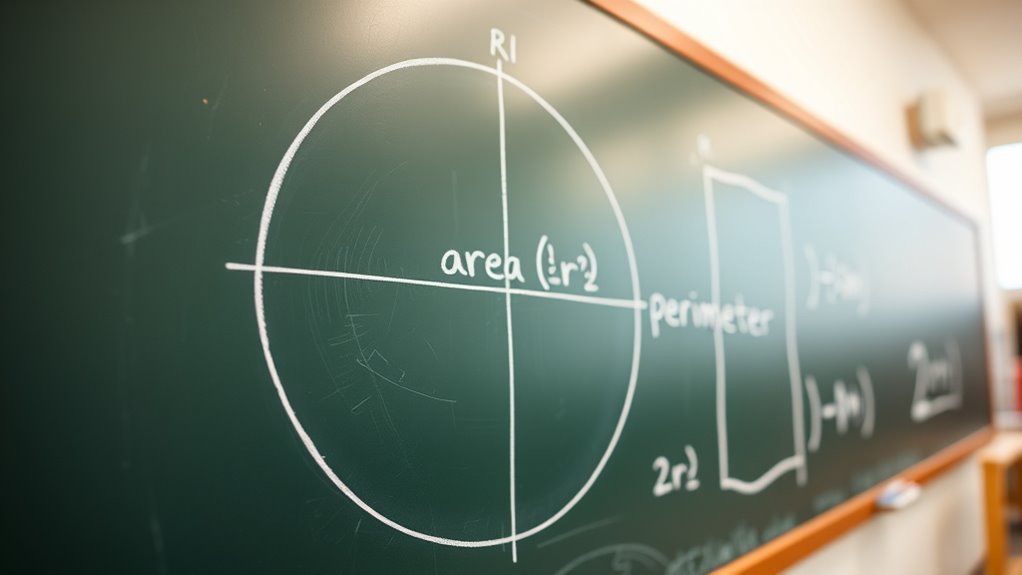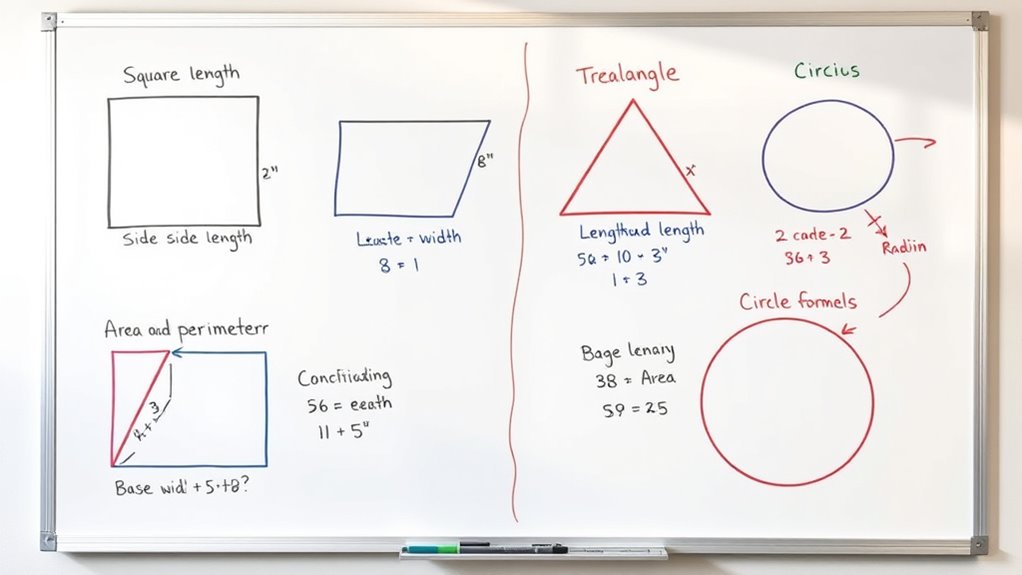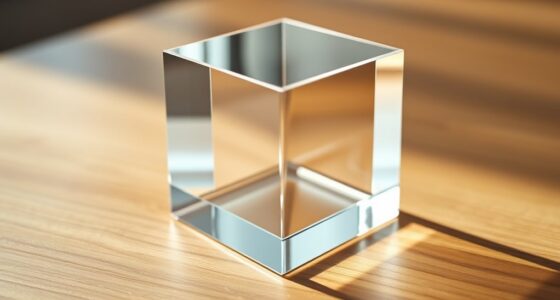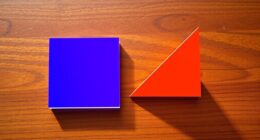To find the area and perimeter of common shapes, start with rectangles and squares: multiply length by width for area and add all sides for perimeter. For circles, use 2π times the radius for circumference and π times radius squared for area. Triangles require adding side lengths for perimeter and using base and height for area. Comparing these formulas helps you understand each shape’s properties. Keep exploring to master these calculations effortlessly.
Key Takeaways
- Rectangles: Perimeter = 2 × (length + width); Area = length × width.
- Squares: Perimeter = 4 × side length; Area = side².
- Circles: Perimeter (circumference) = 2π × radius; Area = π × radius².
- Triangles: Perimeter = sum of all sides; Area = ½ × base × height.
- Formulas vary by shape, highlighting unique properties and calculation methods.
Calculating the Area of Rectangles and Squares

Have you ever wondered how to find the amount of space inside a rectangle or square? To do this, you need to calculate the area, which is the surface covered by the shape. For rectangles and squares, the area is straightforward: multiply the length by the width. If you know the diagonal length, you can use the shape’s symmetry to help find missing side lengths via the Pythagorean theorem, especially in squares where all sides are equal. The shape’s symmetry makes calculations easier because it ensures equal sides or predictable angles. Once you have the side lengths, multiplying them gives you the area. Remember, understanding the shape’s symmetry and diagonal length can simplify the process of finding the space inside these common shapes. Additionally, knowing how to identify the basic geometric properties can improve your ability to perform these calculations more efficiently.
Determining the Perimeter of Rectangles and Squares

Once you know how to find the area of rectangles and squares, calculating their perimeter becomes straightforward. To determine the perimeter, you add up all the sides. For rectangles and squares, this means multiplying the length and width, then adding those results together. If you know the diagonal length, you can use the Pythagorean theorem to find missing side lengths, especially in squares with shape symmetry. In a square, all sides are equal, so the perimeter is four times one side. In rectangles, opposite sides are equal, making the perimeter twice the sum of length and width. Knowing the diagonal length can help verify dimensions or find missing sides, but the key is understanding that the perimeter depends on the shape’s side lengths. Additionally, understanding the contrast ratio of a projector can influence how well details are perceived in different lighting conditions.
Finding the Area and Perimeter of Circles

Are you curious about how to find the area and perimeter of circles? To determine the circle’s perimeter, you need to find its circumference, which is the distance around the circle. The formula for the circle circumference is 2π times the radius (2πr). To find the circle area, you multiply pi by the square of the radius (πr²). Knowing the radius makes both calculations straightforward. If you have the diameter instead, remember that the diameter is twice the radius, so you can adjust the formulas accordingly. These formulas help you quickly find the circle’s dimensions, whether for art projects, construction, or simple measurements. Mastering these basics makes working with circles much easier and more accurate. Additionally, understanding concepts like tuning modifications can help you optimize performance in vehicles, similar to how precise calculations optimize design and engineering tasks.
Calculating the Area and Perimeter of Triangles

Wondering how to find the area and perimeter of a triangle? You can do this by understanding triangle properties and classifications. For example, the perimeter sums all sides, while the area depends on the base and height. Knowing whether your triangle is equilateral, isosceles, or scalene helps choose the right formula. Additionally, understanding triangle classifications can assist in selecting the appropriate calculations for different types of triangles.
Comparing Formulas for Different Shapes

Understanding the formulas for calculating area and perimeter helps you compare different shapes effectively. When you look at shapes like rectangles, triangles, or circles, their formulas reveal unique properties. For example, a rectangle’s perimeter depends on its length and width, while a triangle’s involves side lengths and sometimes the diagonal length. Comparing shapes becomes easier when you analyze their formulas side by side, considering aspects like how the diagonal length influences area calculations. This comparison helps you determine which shape is more efficient for a specific purpose. Recognizing these differences allows you to select the best shape for your needs and understand the relationship between shape and measurement. Shape comparison through formulas enhances your understanding of geometry and practical problem-solving. Understanding shape properties is crucial for applying these formulas effectively.
Frequently Asked Questions
How Do I Find the Area of Irregular Shapes?
To find the area of irregular shapes, you can use irregular shape decomposition, breaking the shape into smaller, regular shapes like rectangles or triangles. Then, calculate each area separately and add them up. Alternatively, you can use area approximation methods, like grid or graph paper techniques, to estimate the area by counting squares or using digital tools. Both methods help you get a practical measurement of complex shapes.
What Are the Units Used for Perimeter and Area Measurements?
Ever wonder what units you should use for perimeter and area? You typically see units like inches, feet, yards, centimeters, meters, and kilometers. When doing unit conversions, you guarantee measurement accuracy for the task at hand. Choosing the right unit depends on the size of the shape and precision needed. Using consistent units helps avoid confusion and ensures your measurements are precise, making your calculations reliable and easy to understand.
How Does Scale Affect Area and Perimeter Calculations?
When considering scaling effects, you need to understand how changing size impacts measurements. As you scale an object, perimeter adjusts proportionally to the scale factor, meaning if you double the size, the perimeter doubles. However, area increases by the square of the scale factor, so doubling the size makes the area four times larger. Always use ratio adjustments to accurately calculate these changes when scaling shapes.
Are There Formulas for 3D Shape Surface Areas?
Imagine you’re designing a spaceship in a vintage sci-fi comic; that’s like working with 3D shapes. Yes, there are formulas for surface areas of 3D shapes, and you use them with volume calculations and 3D shape nets. For example, a cube’s surface area equals six times the square of its side, and a cylinder’s surface area involves its height and radius. These formulas help you understand the shape’s total exterior.
How Can I Visualize These Formulas Effectively?
To effectively visualize formulas for 3D shapes, you should use visualization tools like geometric diagrams and 3D models. These tools help you see how surface areas are calculated by breaking shapes into familiar parts, such as rectangles and triangles. By manipulating these diagrams, you gain a clearer understanding of the formulas, making complex concepts easier to grasp and remember. Visual aids truly make a difference in mastering geometry.
Conclusion
Now that you know the formulas, you’re like a builder with a toolbox, ready to shape any shape you encounter. Remember, each formula is a key that liberates understanding—whether it’s a square, circle, or triangle. Just like assembling a puzzle, combining these shapes helps you see the bigger picture. With practice, you’ll find measuring becomes second nature, turning complex shapes into simple, manageable pieces. Keep practicing, and you’ll be a geometry master in no time.






